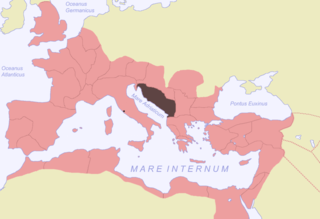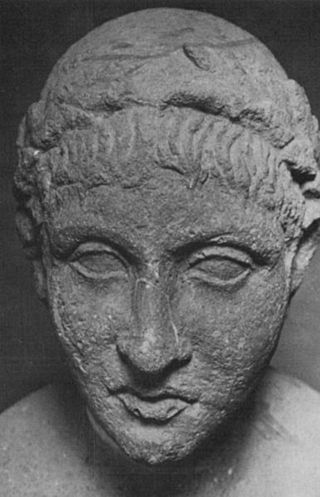Related Research Articles

The Roman calendar was the calendar used by the Roman Kingdom and Roman Republic. Although the term is primarily used for Rome's pre-Julian calendars, it is often used inclusively of the Julian calendar established by the reforms of the Dictator Julius Caesar and Emperor Augustus in the late 1st century BC.
Year 146 BC was a year of the pre-Julian Roman calendar. At the time it was known as the Year of the Consulship of Lentulus and Achaicus. The denomination 146 BC for this year has been used since the early medieval period, when the Anno Domini calendar era became the prevalent method in Europe for naming years.
The 8th century BC started the first day of 800 BC and ended the last day of 701 BC. The 8th century BC was a period of great change for several historically significant civilizations. In Egypt, the 23rd and 24th dynasties lead to rule from Kingdom of Kush in the 25th Dynasty. The Neo-Assyrian Empire reaches the peak of its power, conquering the Kingdom of Israel as well as nearby countries.
This article concerns the period 149 BC – 140 BC.
This article concerns the period 159 BC – 150 BC.
Year 35 BC was either a common year starting on Thursday or Friday or a leap year starting on Wednesday, Thursday or Friday of the Julian calendar and a common year starting on Thursday of the Proleptic Julian calendar. At the time, it was known as the Year of the Consulship of Cornificius and Sextus. The denomination 35 BC for this year has been used since the early medieval period, when the Anno Domini calendar era became the prevalent method in Europe for naming years.
Year 32 BC was either a common year starting on Monday or Tuesday or a leap year starting on Sunday, Monday or Tuesday of the Julian calendar and a common year starting on Monday of the Proleptic Julian calendar. At the time, it was known as the Year of the Consulship of Ahenobarbus and Sosius. The denomination 32 BC for this year has been used since the early medieval period, when the Anno Domini calendar era became the prevalent method in Europe for naming years.
Year 29 BC was either a common year starting on Friday or Saturday or a leap year starting on Thursday, Friday or Saturday of the Julian calendar and a leap year starting on Thursday of the Proleptic Julian calendar. At the time, it was known as the Year of the Consulship of Octavian and Appuleius. The denomination 29 BC for this year has been used since the early medieval period, when the Anno Domini calendar era became the prevalent method in Europe for naming years.
Year 206 BC was a year of the pre-Julian Roman calendar. At the time it was known as the Year of the Consulship of Philo and Metellus. The denomination 206 BC for this year has been used since the early medieval period, when the Anno Domini calendar era became the prevalent method in Europe for naming years.
Year 190 BC was a year of the pre-Julian Roman calendar. At the time it was known as the Year of the Consulship of Asiaticus and Laelius. The denomination 190 BC for this year has been used since the early medieval period, when the Anno Domini calendar era became the prevalent method in Europe for naming years.

Year 220 BC was a year of the pre-Julian Roman calendar. At the time it was known as the Year of the Consulship of Laevinus/Catulus and Scaevola/Philo. The denomination 220 BC for this year has been used since the early medieval period, when the Anno Domini calendar era became the prevalent method in Europe for naming years.
Year 222 BC was a year of the pre-Julian Roman calendar. At the time it was known as the Year of the Consulship of Marcellus and Calvus. The denomination 222 BC for this year has been used since the early medieval period, when the Anno Domini calendar era became the prevalent method in Europe for naming years.
Year 162 BC was a year of the pre-Julian Roman calendar. At the time it was known as the Year of the Consulship of Corculum/Lentulus and Figulus/Ahenobarbus and the Second Year of Houyuan. The denomination 162 BC for this year has been used since the early medieval period, when the Anno Domini calendar era became the prevalent method in Europe for naming years.
Year 180 BC was a year of the pre-Julian Roman calendar. At the time it was known as the Year of the Consulship of Luscus and Piso/Flaccus. The denomination 180 BC for this year has been used since the early medieval period, when the Anno Domini calendar era became the prevalent method in Europe for naming years.
Year 226 BC was a year of the pre-Julian Roman calendar. At the time it was known as the Year of the Consulship of Messalla and Fullo. The denomination 226 BC for this year has been used since the early medieval period, when the Anno Domini calendar era became the prevalent method in Europe for naming years.
Year 270 BC was a year of the pre-Julian Roman calendar. At the time it was known as the Year of the Consulship of Clepsina and Blasio. The denomination 270 BC for this year has been used since the early medieval period, when the Anno Domini calendar era became the prevalent method in Europe for naming years.

Illyricum was a Roman province that existed from 27 BC to sometime during the reign of Vespasian. The province comprised Illyria/Dalmatia in the south and Pannonia in the north. Illyria included the area along the east coast of the Adriatic Sea and its inland mountains, eventually being named Dalmatia. Pannonia included the northern plains that now are a part of Serbia, Croatia and Hungary. The area roughly corresponded to part or all of the territories of today's Albania, Kosovo, Montenegro, Serbia, Bosnia and Herzegovina, Croatia, and Slovenia.

Sicilia was the first province acquired by the Roman Republic, encompassing the island of Sicily. The western part of the island was brought under Roman control in 241 BC at the conclusion of the First Punic War with Carthage. A praetor was regularly assigned to the island from c.227 BC. The Kingdom of Syracuse under Hieron II remained an independent ally of Rome until its defeat in 212 BC during the Second Punic War. Thereafter the province included the whole of the island of Sicily, the island of Malta, and the smaller island groups.

Publius Cornelius Scipio Nasica Corculum was a politician of the Roman Republic. Born into the illustrious family of the Cornelii Scipiones, he was one of the most important Roman statesmen of the second century BC, being consul two times in 162 and 155 BC, censor in 159 BC, pontifex maximus in 150 BC, and finally princeps senatus in 147 BC.
The Roman–Dalmatian wars were a series of conflicts between the Dalmatae (Delmatae) and the Romans. After the fall of the Ardiaei in southern Illyria, the Dalmatae were to pose the greatest force against the Romans in their conquest of Illyria.